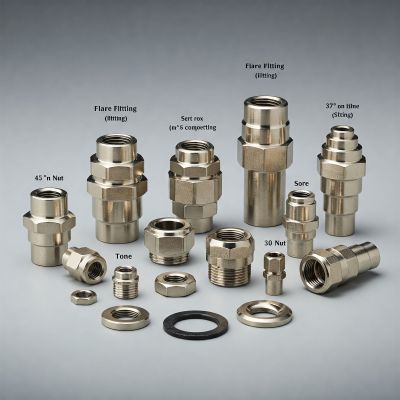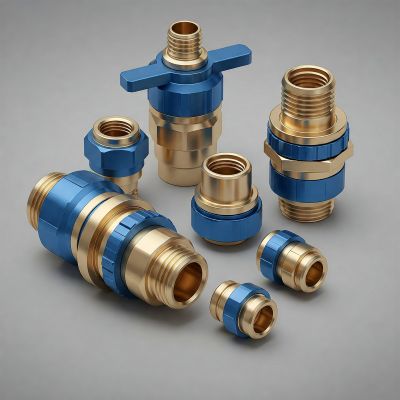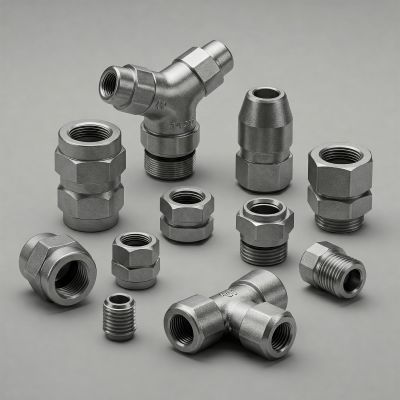Fittings are an essential component of piping and plumbing systems, enabling secure and efficient connections between pipes, hoses, and other components. They help control the flow of liquids and gases while ensuring leak-free performance in various applications.
Selecting the right type of fitting is crucial for system efficiency, durability, and safety. The wrong choice can lead to leaks, pressure loss, or system failure. Each type of fitting has unique features suited for different applications, making it essential to understand their differences.
This comparison will help determine which fitting best suits your needs.
Understanding NPT Compression Fittings
What Are NPT (National Pipe Taper) Compression Fittings?
NPT compression fittings combine the benefits of NPT threading with compression sealing, creating a secure connection between pipes and tubes. They use a tapered thread design that ensures a tight seal through thread deformation.
How They Work: Threading, Sealing, and Compression Mechanism
➡️ NPT threads create a mechanical seal by deforming slightly as they are tightened.
➡️ Compression rings (ferrules) inside the fitting provide additional sealing by clamping onto the pipe.
➡️ The combination of taper threading and compression ensures a leak-free and robust connection.
Common Materials Used
NPT compression fittings are available in various materials, including:
➡️ Brass – Corrosion-resistant and suitable for water and gas systems.
➡️ Stainless Steel – Ideal for high-pressure and high-temperature applications.
➡️ Plastic (PVC, Nylon) – Used in low-pressure applications for chemical and water systems.
Key Applications
➡️ Plumbing Systems – Ensuring leak-proof water supply connections.
➡️ Gas Lines – Providing secure connections for fuel and gas distribution.
➡️ Hydraulic Systems – Withstanding high-pressure fluid applications.
➡️ Industrial Applications – Used in oil, gas, and chemical processing systems.
Overview of Other Common Fitting Types
Flare Fittings
Design and Sealing Method
➡️ Feature a conical seat that forms a metal-to-metal seal when tightened.
➡️ Require flared pipe ends to match the fitting’s cone angle.
Common Applications
➡️ HVAC systems
➡️ Fuel and refrigeration lines
Pros and Cons
Pros:
➡️ Strong resistance to vibration and high pressure
➡️ Reliable metal-to-metal sealing
Cons:
➡️ Requires specialized tools for flaring
➡️ More time-consuming installation
Push-to-Connect Fittings
Mechanism of Operation
➡️ Use an internal gripping mechanism to secure pipes or tubes.
➡️ Allow quick and tool-free installation.
Where They Are Used
➡️ Pneumatic and airline systems
➡️ Water supply lines
Advantages and Disadvantages
Advantages:
➡️ Easy and fast installation
➡️ No need for threading or soldering
Disadvantages:
➡️ Limited to lower pressure applications
➡️ May require additional locking clips for extra security
Barbed Fittings
How They Function with Hoses and Clamps
➡️ Feature ridged barbs that grip onto a hose when a clamp is tightened.
➡️ Often used with flexible tubing and soft hoses.
Best Uses
➡️ Low-pressure fluid transfer
➡️ Irrigation and beverage dispensing systems
Strengths and Weaknesses
Strengths:
➡️ Simple and inexpensive
➡️ Works well with flexible tubing
Weaknesses:
➡️ Not suitable for high-pressure applications
➡️ Requires hose clamps for a secure connection
Compression Fittings (Non-NPT)
How They Differ from NPT Compression Fittings
➡️ Use a straight thread or no thread, relying solely on compression rings for sealing.
➡️ Do not have a tapered thread design like NPT fittings.
Common Uses
➡️ Water supply lines
➡️ Gas distribution systems
Pros and Cons
Pros:
➡️ Easy to install and remove
➡️ No need for pipe threading
Cons:
➡️ Can loosen over time under vibration
➡️ Limited suitability for high-pressure applications
Key Differences Between NPT Compression Fittings and Other Fitting Types
|
Feature |
NPT Fittings (Compression) |
Flare Fittings |
Push-to-Connect |
Barbed Fittings |
Standard Compression Fittings |
|
Threading & Sealing Mechanism |
Tapered threads & compression rings |
Metal-to-metal seal |
Internal gripping mechanisms |
Hose clamping |
Ferrules (no threading) |
|
Ease of Installation |
Requires wrenches & thread sealant |
Needs flaring tool |
Quick, tool-free |
Simple, requires hose clamps |
Requires wrench tightening |
|
Durability & Leak Prevention |
Excellent in high-pressure & vibration |
Excellent in high-pressure & vibration |
Prone to leaks if not properly secured |
Works best in low-pressure systems |
Varies, generally good. |
|
Application Suitability |
Plumbing, gas, industrial |
HVAC, refrigeration, fuel lines |
Pneumatic, water lines |
Fluid transfer, irrigation |
Residential plumbing, gas distribution |
|
Cost & Availability |
More expensive |
More expensive |
More affordable |
More affordable |
Widely available, cost-effective |
When to Use NPT Compression Fittings vs. Other Fitting Types
Factors to Consider When Selecting a Fitting
➡️ Pressure requirements
➡️ Type of fluid or gas being transported
➡️ Installation ease and maintenance
➡️ Budget constraints
Real-World Examples of Ideal Applications for Each Type
➡️ NPT Compression – Gas lines, high-pressure applications
➡️ Flare – Automotive fuel systems, refrigeration
➡️ Push-to-Connect – Quick plumbing repairs
➡️ Barbed – Low-pressure fluid transport
➡️ Standard Compression – Residential water supply
Expert Tips for Ensuring a Secure and Leak-Free Connection
➡️ Use proper sealing materials like Teflon tape on NPT threads.
➡️ Avoid overtightening, which can damage threads.
➡️ Choose fittings made of compatible materials.
Conclusion
Each fitting type serves different needs based on pressure resistance, ease of installation, and leak prevention. NPT compression fittings are best for high-pressure and industrial applications, while other fittings provide benefits in specific use cases.
Consider the system’s pressure, material compatibility, and required durability when selecting a fitting.
Selecting the right fitting enhances safety, prevents leaks, and ensures efficient system performance. By understanding the differences, you can make informed decisions for your specific application needs.
Post time: Apr-21-2025




